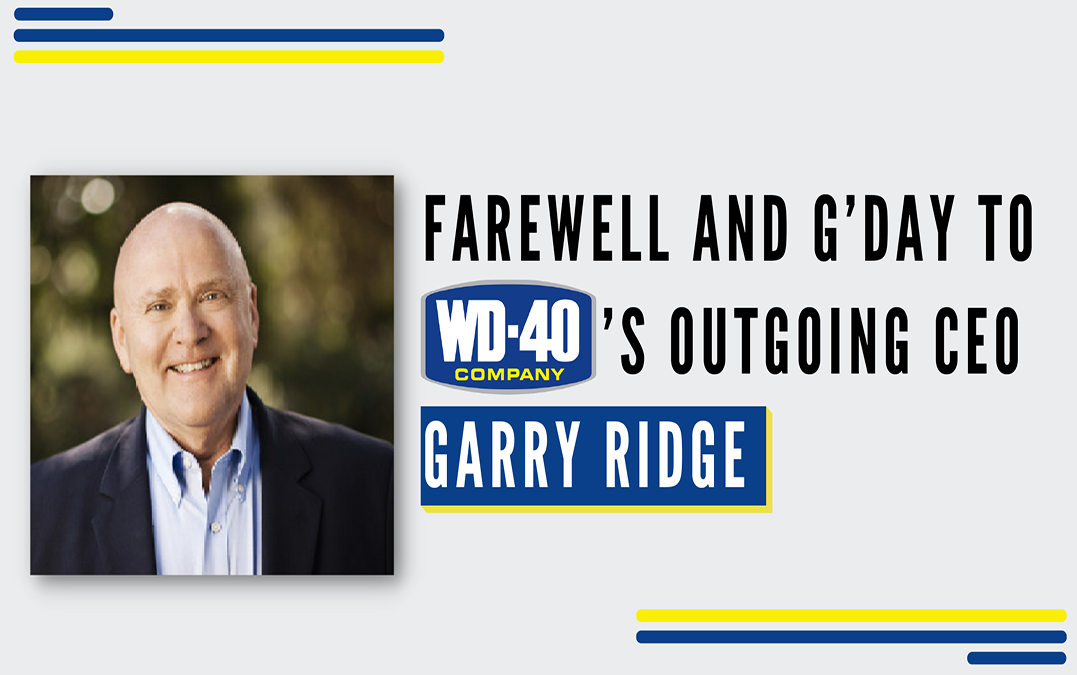
Leadership, Leadership Development, People

6.5 years ago, when a San Diego-based client asked for our help to codify their core values, I immediately reached out to WD-40 CEO Garry Ridge. I was first charmed by Garry when I heard him speak at a leadership conference. His Australian accent, the catch in his voice when sharing a story about balancing the weight of leading a publicly-traded company while making time to be a good soon to his aging mother, the self-deprecating humor, made Garry one of the most approachable speakers I’d heard. And when I emailed Garry to ask if he would be willing to host my client for a “culture field trip” to WD-40, his response was an unqualified yes.
I explained to my client that in order to accelerate their work, I wanted them to experience what it looks like when a company’s core values are hard-wired into their behaviors and, ultimately, organizational performance. This basic connection is true for every organization. The key difference is that a few leaders like Garry Ridge take personal responsibility for codifying the connection between culture and performance. They don’t outsource it to HR or delegate to Marketing. They live it and model it every day.
When I showed up at the WD-40 headquarters with my clients to learn about this culture connection, Garry Ridge personally met us at the door and led us through a one-and-a-half-hour tour. Here are three of the top takeaways we heard from Garry on that culture field trip:
- Create a learning environment. When Ridge was promoted from within as CEO, he knew that growth was being held back partly due to deep silos within the organization. “Those who knew the most about how things worked guarded that knowledge, which gave them power,” Ridge said. He immediately set to work to define the concept of learning moments. Over time, he built trust in the concept by showing that no one would be punished for trying something new and sharing knowledge about what worked and what did not. At today’s WD-40, knowledge is shared and information moves easily.
.
- Personalize accountability and responsibility. In Helping People Win at Work, a book co-authored with Ken Blanchard, Ridge shares the unique WD40 performance review system. Employees develop measurable, achievable goals that will help the company reach its annual strategic targets. They describe what ‘A’ work looks like, rate their own progress each quarter, and review these ratings with their manager. The manager’s role is to help employees achieve all As. Ridge says, “If you help your people get As, your performance management system will ignite them to blow away your customers with outstanding service. Because people who feel good about themselves want to return the favor.”
.
- Get your values off the wall. WD-40 doesn’t just want good performers, it wants good performers who are also good citizens. Ridge believes that values must be at the core of your business model, not just words engraved in a plaque on the wall. Not only does the company have six, clear-to-understand values, but they are ranked in order of importance. He explained, “Life is about values conflicts. When these conflicts arise, people need to know which value to focus on.” Employees are taught the values at orientation, assigned to ‘tour guides’ to help explain values in action, and hold themselves accountable for demonstrating the values, which make up 30% of their performance review.
 On August 31st of this year, Garry is stepping down as CEO of WD-40 after 25 years of service. He plans to launch a consulting practice called The Culture Coach. I, for one, look forward to supporting Garry in this next chapter just as he has so graciously supported mine. So, farewell to Garry as WD-40 CEO and G’day to your new, exciting role!
On August 31st of this year, Garry is stepping down as CEO of WD-40 after 25 years of service. He plans to launch a consulting practice called The Culture Coach. I, for one, look forward to supporting Garry in this next chapter just as he has so graciously supported mine. So, farewell to Garry as WD-40 CEO and G’day to your new, exciting role!
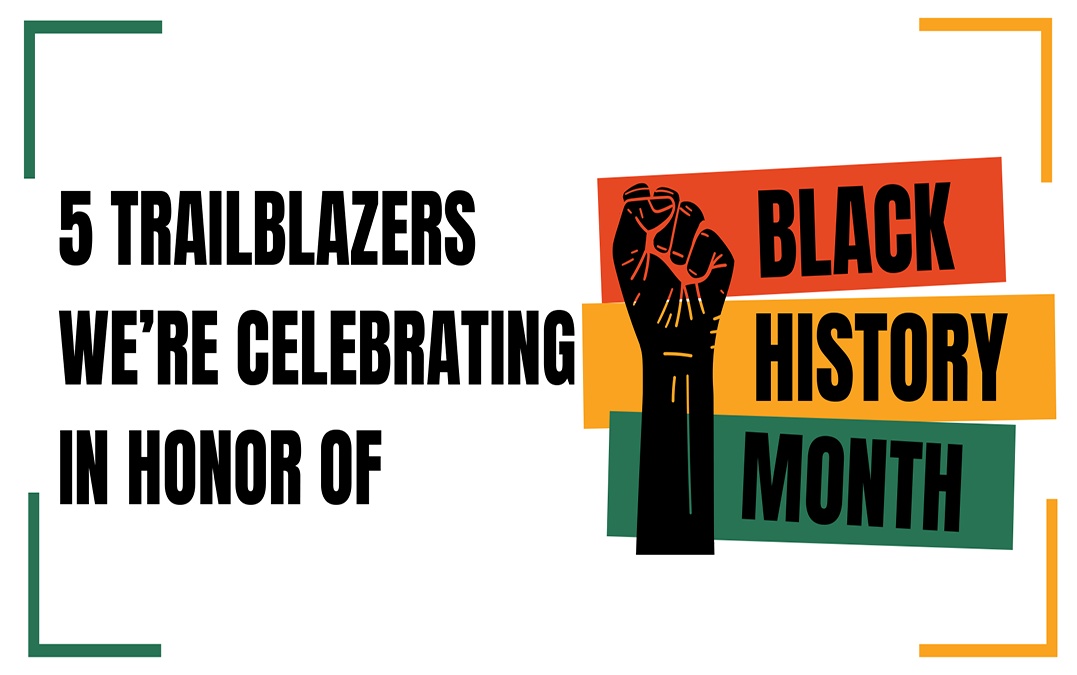
Diversity, Equity, Inclusion, People
When you think of pioneers in African American history, who comes to mind? For most of us, it’s leaders like Dr. Martin Luther King, Jr., Rosa Parks, Maya Angelou, and James Baldwin – and rightfully so. But, if names like Pauli Murray, Matthew Henson, and Katherine Johnson don’t ring a bell, you’re not alone. In honor of Black History Month, here’s an opportunity to learn about activists, adventurers, and scientists who enriched the American culture by following their calling – often breaking barriers for those who rose to fame in recent history.
 1. Pauli Murray. Overlooked by history, Pauli Murray was a legal trailblazer whose ideas influenced Ruth Bader Ginsburg’s fight for gender equality and Thurgood Marshall’s civil rights arguments. Pauli was a Black, non-binary luminary, lawyer, activist, poet, and priest who transformed our world.
1. Pauli Murray. Overlooked by history, Pauli Murray was a legal trailblazer whose ideas influenced Ruth Bader Ginsburg’s fight for gender equality and Thurgood Marshall’s civil rights arguments. Pauli was a Black, non-binary luminary, lawyer, activist, poet, and priest who transformed our world.
Learn more: My Name is Pauli Murray (Amazon Prime, 2021)
Quote: In not a single one of these little campaigns was I victorious. In other words, in each case, I personally failed, but I have lived to see the thesis upon which I was operating vindicated. And what I very often say is that I’ve lived to see my lost causes found.
2. Buck Franklin. Born in 1879 in what is now known as Oklahoma, Buck Colbert Franklin studied law by mail, and after passing the bar, moved his family to Tulsa. Tulsa’s Greenwood District was one of the wealthiest communities in the United States. In 1921, a young Black man was arrested over an incident with a White girl which led to the Tulsa Race Massacre destroying more than 35 blocks along with 1,200 homes. 300 died, mostly Blacks. After the massacre, Tulsa city council passed an ordinance preventing Black people from re-building their homes. Buck Franklin sued the city in Oklahoma Supreme Court and won.
Learn more: A Long-Lost Manuscript Contains a Searing Eyewitness Account of the Tulsa Race Massacre of 1921 (Smithsonian Magazine)
Quote: This is true today and will continue to be true to the end of time: that most great issues are moral, not political; are human, not racial; that the statesman can never be displaced by the politician without harmful dislocations of natural evolutionary processes; and that the entire world is both mentally and spiritually ill today because of this derangement.
3. Matthew Henson. While the geographic location of the North Pole was understood in theory, the hostile environment was not explored until 1909 when Matthew Henson and Robert Peary became the first people to reach the top of the world. Although Peary was the public face of their partnership, Henson was the front man in the field. With his skills as a carpenter and craftsman, Henson personally built and maintained all of the dog sleds used on their expeditions. He was fluent in the Inuit language and established a rapport with the native people of the region. Henson learned the methods the Inuit used to survive and travel through the incredibly hostile landscape of the Arctic.
Learn more: The Legacy of Arctic Explorer Matthew Henson (National Geographic)
Quote: There can be no conquest to the man who dwells in the narrow and small environment of a groveling life, and there can be no vision to the man the horizon of whose vision is limited by the bounds of self. But the great things of the world, the great accomplishments of the world, have been achieved by men who had high ideals and who have received great visions. The path is not easy, the climbing is rugged and hard, but the glory at the end is worthwhile.
4. Benjamin Banneker. A self-taught astronomer and farmer, Banneker is best known for his series of highly successful astronomical almanacs that ‘predicted’ events such as solar eclipses, sunrises, and sunsets. Many passages also contained predictions of the weather and seasonal changes and medical remedies and advice on planting crops. Banneker sent a copy of his first almanac to then U.S. Secretary of State Thomas Jefferson along with other documents explaining his position on racial equality. His earlier accomplishments included constructing an irrigation system for the family farm. At the age of 22, having seen only two timepieces in his lifetime – a sundial and a pocket watch – Banneker constructed a striking clock that was reputed to keep accurate time and ran for more than 50 years.
Learn more: Benjamin Banneker (YouTube)
Quote: Presumption should never make us neglect that which appears easy to us, nor despair make us lose courage at the sight of difficulties.
5. Katherine Johnson. Johnson was the youngest of four children. She would show an interest and aptitude for mathematics at a young age, which her parents nurtured into her adulthood. Because her home county did not offer public schooling for African-American students past the eighth grade, her family arranged for her to attend high school in West Virginia. Johnson attended West Virginia State University, and graduated summa cum laude with degrees in Mathematics and French at the age of 18.
Post-graduation, she worked for a time as a schoolteacher before joining NACA at Langley Memorial Aeronautical Laboratory in 1952. At NACA, Johnson first worked as a “human computer” and then, after NACA became NASA, on the space program, where she became an aerospace technologist, calculating the trajectories for many NASA missions.
During the Mercury space missions, when NASA began using electronic computers for the first time, astronaut John Glenn apparently refused to fly unless Johnson first verified the calculations. She also published 26 scientific papers throughout her career. Her work at NASA was profiled in the film Hidden Figures.
Learn more: September 2017 Video Interview (NASA.gov)
Quote: When the space program came along, I just happened to be working with guys and when they had briefings I asked permission to go, and they said the girls don’t usually go. And I said, well, is there a law? They said no and then my boss said let her go.
If you’d like to hear more stories to celebrate Black History Month, listen to this beautiful StoryCorps collection featuring Black voices in conversation.
Question: What stories would you want to see elevated in the narrative of American history?
Driven by the premise that excellence is the result of aligning people, purpose and performance, Center for Executive Excellence facilitates training in leading self, leading teams and leading organizations. To learn more, subscribe to receive CEE News!
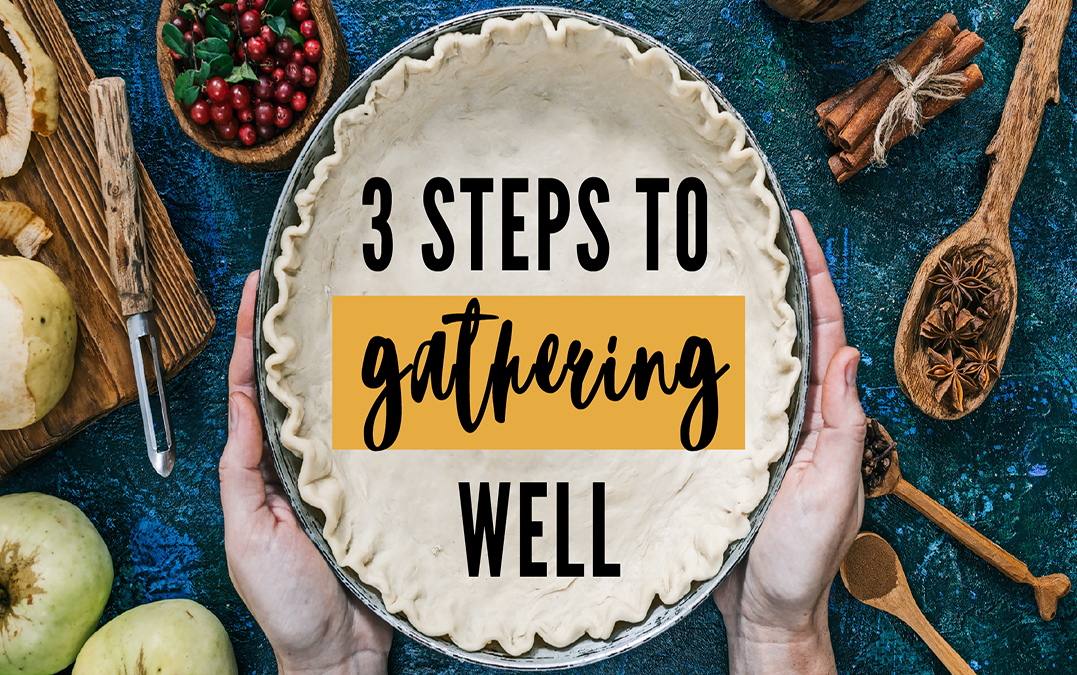
Leadership, People
On Thanksgiving Day, most of us look forward to enjoying plenty of good food. But, plenty of good conversation? Not on the menu.
With family and friends of all generations and mixed political persuasions coming together for the holiday, avoiding conversational controversy can be tricky. Even once safe topics like the weather can quickly turn into a stormy debate. As much as 64% of Americans report that their mental stress levels rise this time of the year. But conflict mediator Priya Parker suggests that we use gatherings like Thanksgiving to connect meaningfully, take risks, and be changed by our experience.
In her 2019 TED Talk, Parker offers three steps to turning everyday get-togethers into transformative gatherings.
Step 1: Embrace a specific, bold purpose. Instead of focusing on all of the little things — menu, music, seating arrangements — focus instead on the conversation, connections, and purpose that’s bringing everyone together. Take a pause to incorporate meaning beyond the “off the rack” Thanksgiving Day goals. Ask yourself, “what is the purpose of gathering with friends and family today?” or, “who can I learn something new from today?”
Step 2: Cause good controversy. “Human connection,” says Parker, “is threatened as much by unhealthy peace as it is by unhealthy conflict.” Around the Thanksgiving table, ask people to share stories rather than opinions. Ask for stories about when their opinions changed or their paradigm shifted. Give people a way into each other to share vulnerability and connect on a human level.
Step 3: Create temporary structure using pop-up rules. These are one-time constitutions such as, whoever brings their phone to the dinner table does the dishes. Pop-up rules like this allow us to harmonize our behavior and gather across differences without having to be the same.
“At their best,” Parker suggests, “gatherings allow us to be seen for who we are and to see.” Gatherings flourish when real thought goes into them, when structure is baked in, and when a host has the curiosity, willingness, and generosity of spirit to try. Read more in Parker’s book, “The Art of Gathering: Create Transformative Meetings, Events and Experiences.”
Question: What tips do you have on how to make your gatherings less routine and more meaningful?
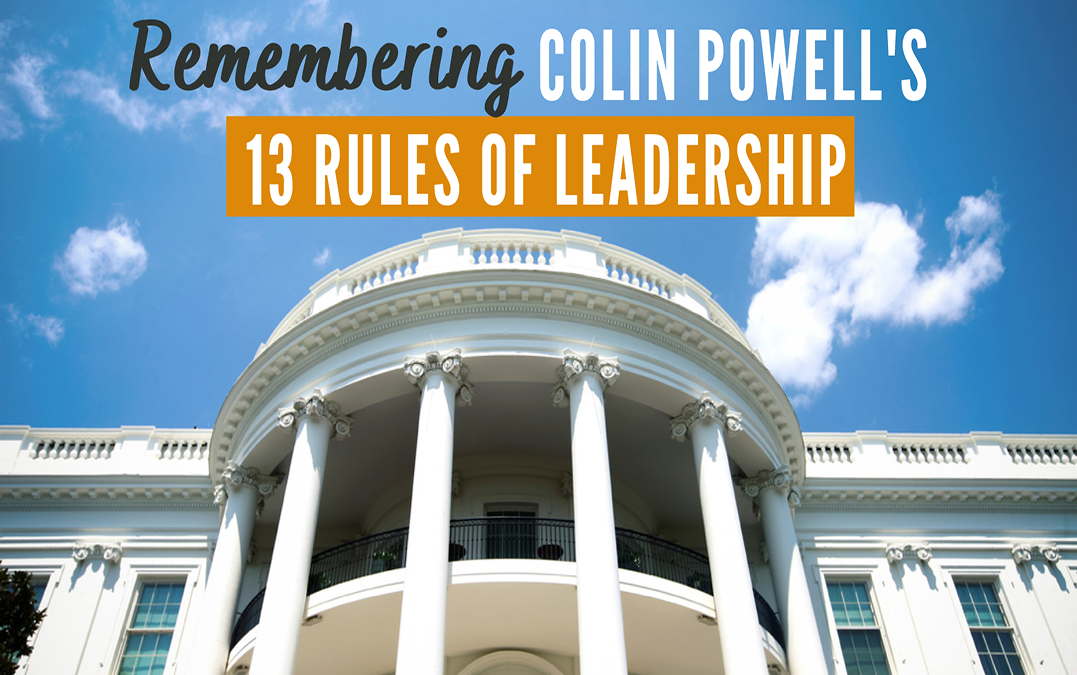
Leadership, People
Yesterday, America lost a legendary public statesman and former Secretary of State, Colin Powell.
“Leadership is the art of accomplishing more than the science of management says is possible.” – Colin Powell
Since his retirement from public office in 2004, Powell has spent much of his time sharing his leadership knowledge with the business community. In his 2012 book, It Worked For Me, Powell attributed his success to hard work, straight talk, respect for others, and thoughtful analysis.
At the heart of the book are Powell’s “13 Rules” — ideas that he gathered over the years that formed the basis of his leadership principles.
Colin Powell’s 13 Rules of Leadership are listed below. They are full of emotional intelligence and wisdom for any leader.
- It ain’t as bad as you think! It will look better in the morning. Leaving the office at night with a winning attitude affects more than you alone; it conveys that attitude to your followers.
- Get mad then get over it. Instead of letting anger destroy you, use it to make constructive change.
- Avoid having your ego so close to your position that when your position falls, your ego goes with it. Keep your ego in check, and know that you can lead from wherever you are.
- It can be done. Leaders make things happen. If one approach doesn’t work, find another.
- Be careful what you choose. You may get it. Your team will have to live with your choices, so don’t rush.
- Don’t let adverse facts stand in the way of a good decision. Superb leadership is often a matter of superb instinct. When faced with a tough decision, use the time available to gather information that will inform your instinct.
- You can’t make someone else’s choices. You shouldn’t let someone else make yours. While good leaders listen and consider all perspectives, they ultimately make their own decisions. Accept your good decisions. Learn from your mistakes.
- Check small things. Followers live in the world of small things. Find ways to get visibility into that world.
- Share credit. People need recognition and a sense of worth as much as they need food and water.
- Remain calm. Be kind. Few people make sound or sustainable decisions in an atmosphere of chaos. Establish a calm zone while maintaining a sense of urgency.
- Have a vision. Be demanding. Followers need to know where their leaders are taking them and for what purpose. To achieve the purpose, set demanding standards and make sure they are met.
- Don’t take counsel of your fears or naysayers. Successful organizations are not built by cowards or cynics.
- Perpetual optimism is a force multiplier. If you believe and have prepared your followers, your followers will believe.
Colin Powell’s rules are short but powerful. Use them as a reminder to manage your emotions, model the behavior you want from others, and lead your team through adversity.
Question: Which of the 13 rules have you mastered? Which one can you work on today?
Driven by the premise that excellence is the result of aligning people, purpose and performance, Center for Executive Excellence facilitates training in leading self, leading teams and leading organizations. To learn more, subscribe to receive CEE News!
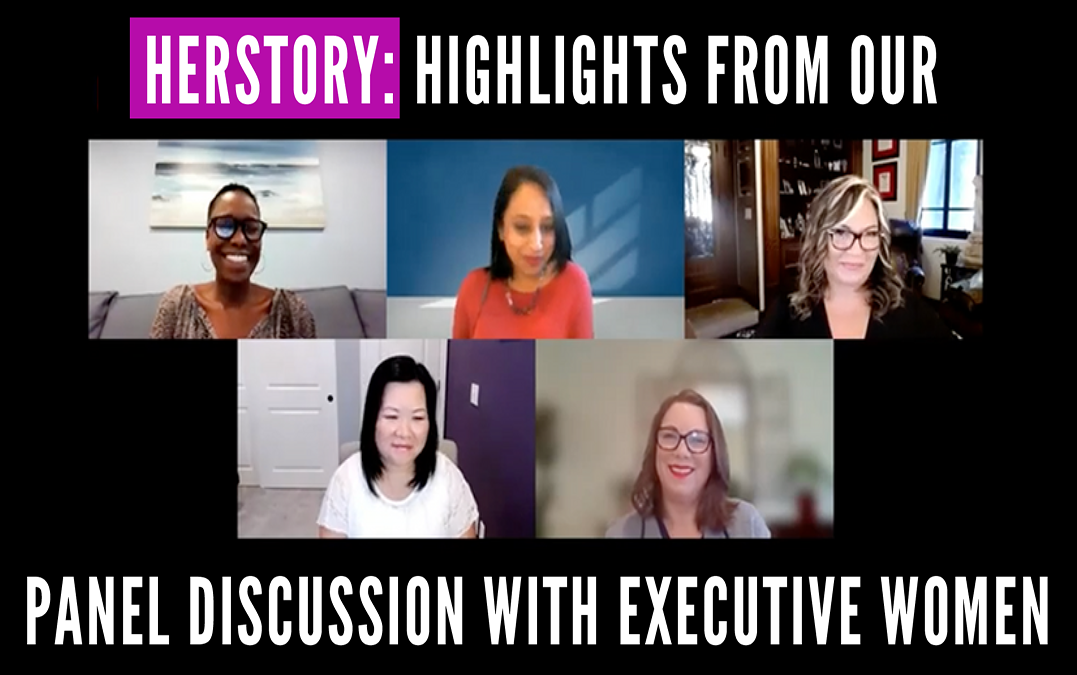
Diversity, Equity, Inclusion, People
If you read my post last week, you’ll know that we just completed our third quarterly panel discussion on DEI (diversity, equity, and inclusion). This time, we focused on how to close the gender equity gap in the workplace with a discussion titled, HERstory: A Conversation With Executive Women About Gender Equality. Here’s a recap of who participated and some of the key takeaways.
Monica Davy, our moderator, serves as the Chief Culture, Diversity and Inclusion Officer at Vizient, where she is responsible for guiding the organization’s overarching strategy, program implementation and ongoing support for culture and D&I initiatives. Panelist Nupur Bhushan joined us from New Zealand where she serves as the General Manager for the ResMed business in Australia and New Zealand. Alessandra Lezama is the founder and CEO of TOOTRiS, Child Care On-Demand, a technology platform that is reinventing how parents find, enroll, and pay for quality child care. MyMy Lu recently joined Thermo Fisher Scientific, a world leader in serving science with a global team of 80,000 colleagues. MyMy serves as the company’s Director of Diversity & Inclusion. Antonia Luna serves as the Senior Vice President of Branch Network and Support Services at California Coast Credit Union, where she is responsible for strategic direction, growth, member experience, delivery channels and operational excellence.
Here are a few highlights from this thought-provoking and candid discussion.
1.As you think about your career and how far you’ve come, is there a moment that you can point to that changed the trajectory of your career or propelled you to where you are today?
MyMy: One of my memorable achievements is being able to conceptualize and launch a broadband adoption program to help individuals from low-income families gain access to the internet. The program became an industry standard for closing the digital divide.
At that time, I was asked to partner with my boss to take a meeting with an external partner on how we could collaborate to create this program. My boss had a calendar conflict and opted to attend the other meeting, though I told her I thought this one would be important not to miss. I was extremely frustrated that my boss didn’t see the urgency of this meeting and I was quite junior in my role. But I decided to take the meeting alone and ended up with an opportunity to build the program from the ground up. That program gave me visibility at my company, in my industry and community, and propelled me to leadership opportunities. We even got a shoutout from President Obama!
Lesson learned: never pass up an opportunity to stretch, do your homework and be ready when opportunity strikes, what seems like extra work may end up being your ticket to do much more. And when opportunity strikes, work your butt off to make sure you can show your potential and impact.
Antonia Luna: I started in Credit Union’s when I was a 19-year old single mom. At that point I had no idea what I wanted for a career. I was just trying to support myself. But I remember instinctively knowing that I was not going to stay a back office posting teller my entire life. I was motivated to learn more and asked the bosses to teach me everything about the credit union. They allowed me to work in every department. After learning all I could at that Credit Union, I made the best decision of my career and left my comfort zone and went to work for a Bank as a manager with a ‘can do’ attitude and no management experience. That decision changed the trajectory of my career. I learned from that experience to not be afraid to ask for a job, even if I had no experience. Because I had confidence in my ability to lead people and was able to learn quickly I believed I can do anything. And I still believe that today. I guess you can say I was “leaning in” before Lean In was a thing!
2. The modern workplace has really changed, and the COVID pandemic amplified the need for workplace flexibility. What are some workplace flexibility policies or practices that companies should take action on to support women and accelerate progress in closing the gender gap in the workforce?
Alessandra Lezama: Just months before the pandemic hit, women had crossed a major threshold as they had become the majority of jobholders in the U.S. Since then, millions of women have suffered a big reversal, with nearly 3 million American women leaving the workforce, mainly due to child care demands. When women leave the workforce, they lose much more than just their annual salary; the cost of this decision follows them for life. After taking into account the potential wage growth and lost retirement savings over time, a woman who leaves the workforce loses up to four times their annual salary per year.
Much of the discussion surrounding workplace flexibility especially during the pandemic has been around working remotely when job duties allow, non-standard start and end times, and extended FMLA. While these are all policies that help, they are not the key to supporting women in the workforce. Women need access to affordable quality child care to have the peace of mind required to focus on their careers. Whether working from home or in the office or on the go! Employers need to recognize that child care is not just a family issue, it’s a business issue. We need a digital convergence that connects all stakeholders (like healthcare) – including public subsidy and employer sponsored programs – conveniently available in real time so we can provide a solution that’s good for everyone, not just for the segment of the market that can afford it.
Antonia Luna: I agree with Alessandra. Working moms typically had the “second shift” or “double shift”, taking care of the family after a full day of work. When schools closed, women found themselves having to work a “double-double”. Many of the moms had to choose between showing up at front-line jobs or caring for and educating their children. But it’s not just the children, some women care for aging parents too. Policies such as flexible work schedules and hybrid remote options are important to consider, depending on the job of course. Also, shifting the mindset from time spent in the office to assessing workers’ performance on their delivery and achievements. Providing unconscious bias training can also help create the awareness needed at all levels to close the gender gap.
3. In 2019, more than 180 CEOs signed an open letter opposing state efforts to restrict reproductive rights in America. As of this May, more than 500 such restrictions have been introduced in the U.S. so far in 2021. What role should female leaders play in helping their C-suite navigate the grey areas of this highly divisive issue?
Alessandra Lezama: Personal values are the real pivot of the controversy surrounding reproductive rights in America. While we all have a right to our credence, the prevailing truth is that reproductive rights affect a woman’s body, and this is not subject to be controlled by the government or a foreign party. Women’s leadership is key in magnifying our voice and garnering support from men on women’s right to decide over their own bodies indistinctively from personal beliefs or values.
Nupur Bhushan: This question is a tough one for me primarily because I am not based in the U.S. From afar, this seems more of a political issue than a gender equality issue. That said, many gender challenges are sensitive and need to be navigated with open dialogue with the C-suite. A combination of employee engagement data, open conversations that enable personal experiences and story-telling, feedback from ERGs, external best practices, education, awareness and actual demographic data with trends on hiring, promotions, and turnover can be very powerful tools in getting the C-suite engaged. We’ve navigated pronouns, common bathrooms, and parental leave policies successfully in many cases. Of course, we haven’t always succeeded either, but the key is not to give up!
4. The racial justice movement brought to the forefront some of the systemic barriers that have also plagued the workplace. The concept of a concrete ceiling points to the factors preventing women of color from advancing at work. In your experience and/or opinion, how can companies be more mindful of the hurdles that women of color face, differently from their colleagues?
Antonia Luna: The concept of a concrete ceiling is such an important visual. With a glass ceiling you can see the possibility, but can’t get to it. You can’t see through concrete, so you don’t even get to see the possibility. In my opinion, we need to have an honest and open dialogue about gender, race and ethnicity, biases and micro-aggressions. We need to be intentional about becoming allies for women of color, advocating for them behind closed doors ensuring they are valued for their efforts, and speaking up when we hear micro-aggressions in the workplace.
MyMu Lu: This question underscores the importance of intersectionality. Though a woman of color, what I experience also can’t be generalized to all women of color. But I can share that as an Asian immigrant woman from a traditional Chinese family, these dimensions of my identity do impact my experience at work. (I was taught that women don’t need to be that successful, younger siblings shouldn’t speak up, and subordinates never question authority. Yet the workplace demands that I be confident but not controlling, work harder to prove that I do have the potential, stay on my toes to make sure I don’t give anyone an excuse to believe my success was derived from anything other than my achievements. All of this takes a mental toll and can lead to burnout.)
There are a couple of realities we need to acknowledge. First, the American workplace is often characterized by white and masculine standards of professionalism and qualifications. From superficial things like attire or hairstyle—I once had a colleague who was told she needed to wear more blazers and cut her hair short in order to look more professional and like a leader. Then there are arbitrary things like how leaders must act and work. You’ve likely heard that certain people (men) have executive presence and probably gravitated towards them too. But what are we weighing when say that? Are we truly considering their contributions or making an assessment based on societal stereotypes that have been planted in our heads? Do we let the collaborative nature of women unfairly peg them as lacking control or command? Women of color, in particular, must work twice as hard to fit the mold and disprove myths about their qualifications. I think companies can be more mindful of who they glorify and what they personify as leadership qualities so that women and women of color do not have to exert extra energy to fit the mold. If collaboration and giving everyone a voice is a positive trait, reinforce that at every level. Challenging the traditional “look and feel” of a leader will help us be more objective about performance and potential.
Second, the lack of representation makes it difficult for women of color to feel like they belong. Not seeing people like them (and this applies to any group), can deter women from even entering the field—many male-dominated industries can attest to how difficult it can be to recruit women and retain them. Lack of diversity and representation also reinforces unfair stereotypes of who is qualified to do certain roles. If we’re accustomed to female executive assistants, are we likely to think a male could not do that job as well—is that fair for males or females? I know many of us have heard, “I don’t really see her in that role…” Are those assessments objectives or an unconscious bias? Are we creating barriers to entry if we compare a candidate to a pool that doesn’t include their identity in the first place? Does the lack of women of color in leadership make them less qualified? I believe companies can be more intentional about hiring and promoting deserving women so that women, and women of color, can see a pathway to success. Have objective measures of success and don’t put the burden on women to prove their potential simply because we haven’t seen them in that role.
These are realities and challenges that any group may face. But a woman of color is fighting gender bias and racial bias—a double whammy. A lack of belonging can lead to a lack of psychological safety and self-doubt. The extra effort women of color must exert causes more mental stress, takes a bigger toll and distracts from what we can gain if women of color can bring their whole selves to work. Being intentional about supporting women of color simply levels the playing field and acknowledges that this group faces additional barriers differently from their peers.
5. Allyship, mentorship, and sponsorship are critical for supporting gender equity. What success have you personally or your company experienced in these areas?
Nupur Bhushan: Personally, when I moved to Australia, I really struggled with no network or women of color that I could seek for support in my initial years. Since then, I have been determined to help and support women of color, specifically from Indian sub-continent, if I can. Over the past 4-5 years, I’ve taken on at least 1 if not 2 mentees every year. I believe I have helped influence some career and personal decisions through these experiences but more importantly I learned a lot more about myself and from each of the amazing women I’ve had the privilege to speak with.
ResMed delved in trying out mentoring and coaching in multiple ways such as encouraging each C-suite member to take on 2 mentees as a part of their OKRs; tribally pairing mentors/mentees in a particular function with a diverse set of mentors from alternate areas of specializing has been an amazing opportunity for two-way learning.
Alessandra Lezama: In my experience, men have played an important role in providing me with a platform to have a voice and more importantly to have their ear. While it’s true, and much is said about how important it is for women to help other women in the workforce, in order to achieve true gender equality, we need men on board! Recognizing that men and women in the workplace can both be extremely successful while having completely different perspectives, work styles, etc. must be exemplified by men promoting and sponsoring more women purposefully.
Thanks to our amazing moderator, esteemed panelists, passionate sponsors, engaged participants, and powerhouse team, for showing up, for sharing, and for continuing to build community around getting equity right. We are honored to present quality programs like this to continue taking you from what is to what is possible.
Question: How would you rate your organization on closing the gender gap in the workplace?
Driven by the premise that excellence is the result of aligning people, purpose and performance, Center for Executive Excellence facilitates training in leading self, leading teams and leading organizations. To learn more, subscribe to receive CEE News!
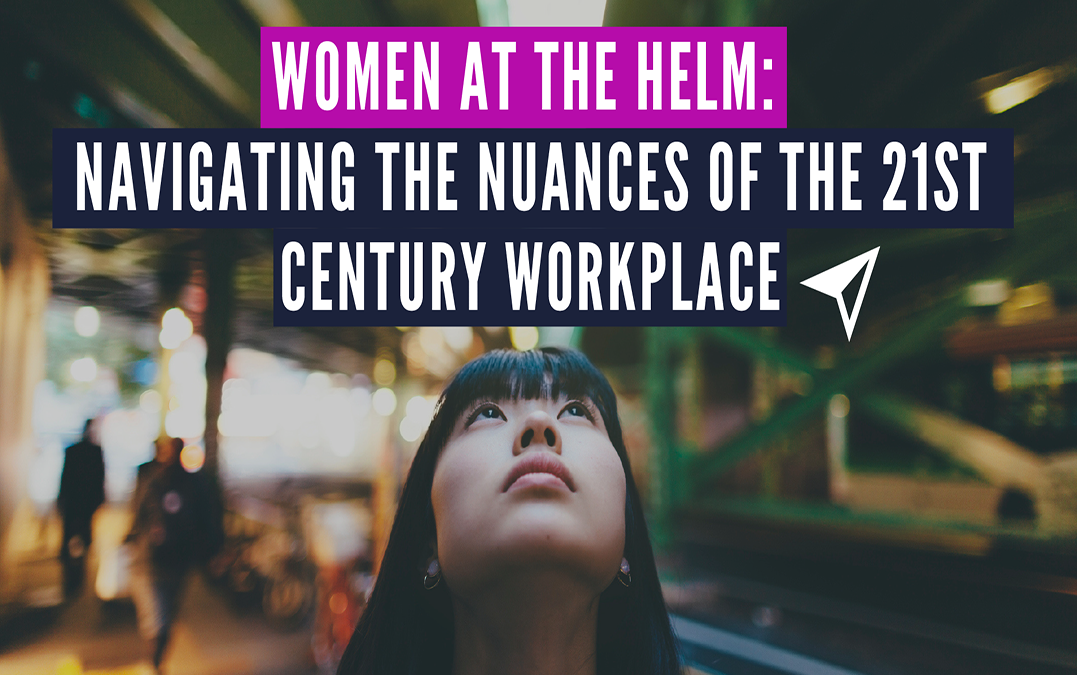
Diversity, Equity, Inclusion, People
What role should female leaders play in helping their C-suite navigate the issue of state efforts to restrict reproductive rights in America?
What are some workplace policies or practices that companies should enact to support women and accelerate progress in closing the gender gap in the workforce?
These are just two of the questions tackled by participants in our recent panel discussion, HERstory: A Conversation With Executive Women About Gender Equality. As I listened to the responses from the panelists, I was struck how women executives are uniquely suited to navigate the nuances of the 21st century workplace.
Collectively, these women bring over 110 years of experience, hold degrees from Howard University School of Law, UCLA, Goa Institute of Management (Sattari, India), Ma Christina Del Escorial (Madrid, Spain), and California State University, and impact nearly 92,000 employees across the globe. More importantly, the panelists have firsthand experience of what it’s like to not be a part of the dominate group in the workplace. They’ve juggled child rearing as working moms and broken the deep cultural expectations about the role of women at work and at home.
These are executives who have sharpened their leadership skills in the face of microaggression, gaslighting, unconscious bias, and sexism, making them exceptionally well suited to lead the diversity, equity, inclusion and belonging (DEIB) challenges at the highest levels of business. The research clearly shows not only that the business case for DEIB remains robust but also that the relationship between diversity on executive teams and the likelihood of financial outperformance has strengthened over time.
It was an honor to provide a platform for these exceptional women to share and a joy to watch them shine. If you didn’t get a chance to see the panel discussion, we’ve included a link to watch the replay here. I encourage you to watch it and share it with your team. Workplaces that work for women, work for everyone.
Question: What are some specific ways your organization is closing the gender gap and supporting women in the workplace?
Watch the replay of HERstory: A Conversation With Executive Women About Gender Equality:



 On August 31st of this year, Garry is stepping down as CEO of WD-40 after 25 years of service. He plans to launch a consulting practice called The Culture Coach. I, for one, look forward to supporting Garry in this next chapter just as he has so graciously supported mine. So, farewell to Garry as WD-40 CEO and G’day to your new, exciting role!
On August 31st of this year, Garry is stepping down as CEO of WD-40 after 25 years of service. He plans to launch a consulting practice called The Culture Coach. I, for one, look forward to supporting Garry in this next chapter just as he has so graciously supported mine. So, farewell to Garry as WD-40 CEO and G’day to your new, exciting role!

 1. Pauli Murray. Overlooked by history, Pauli Murray was a legal trailblazer whose ideas influenced Ruth Bader Ginsburg’s fight for gender equality and Thurgood Marshall’s civil rights arguments. Pauli was a Black, non-binary luminary, lawyer, activist, poet, and priest who transformed our world.
1. Pauli Murray. Overlooked by history, Pauli Murray was a legal trailblazer whose ideas influenced Ruth Bader Ginsburg’s fight for gender equality and Thurgood Marshall’s civil rights arguments. Pauli was a Black, non-binary luminary, lawyer, activist, poet, and priest who transformed our world.







